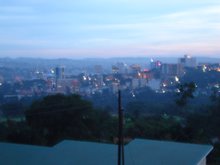Traditionally each Buganda king would establish his own palace and when he died, he would be buried there. In the 19th century, for a reason I can’t remember at the moment, and now the past four kings have been buried here in this hut, the second largest thatch-roofed hut in the world:

Surrounding the hut are a number of smaller dwellings where the wives of the king used to live. P.’s neighbor with five wives has got nothing on the kings who can have, like, 50. If one of the wives died, one of her unmarried sisters or cousins or aunts or whoever would come to take her place. If she only had married female relatives, they were off the hook and would just have to come for a few days to pay their respects. The widows of the last king still live around the palace and take care of it.

Inside the hut, there are four mounds behind a fence of spears, with pictures of each of the kings. The bodies are not buried directly under these mounds. Buganda kings do not “die,” they “get lost in the forest.” The first two Buganda kings – hundreds of years ago – actually did get lost in the forest. Their bodies were never found. In the hut, there is a curtain made of backcloth – a leathery hide made from the bark of a tree. Behind the curtain is the figurative forest. When the bodies were buried, a hole was dug thirteen feet deep in front of the curtain and then a tunnel dug backwards so the bodies would actually rest behind the curtain, or in the forest. Which I think is a rather nice tradition.

No comments:
Post a Comment